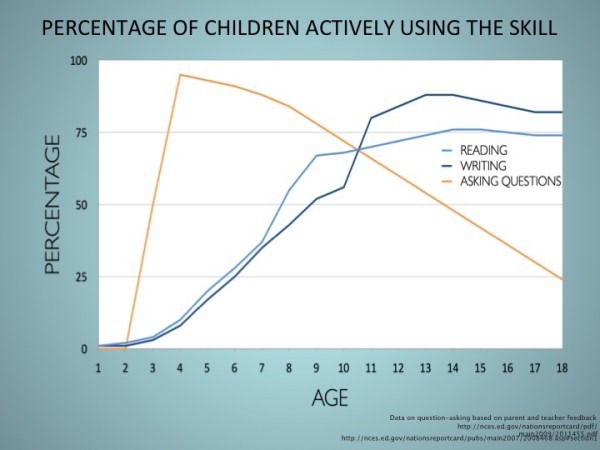In the Curiosity is the Cat post, Will Richardson makes the argument that curiosity is the only “C” that truly matters. Richardson alludes to the variety of authors who have pointed to 4, 7, or more Cs of 21st Century learning and suggests that without curiosity you wouldn’t have critical thinking, creativity, communication, and collaboration. He also points to the reality that our children are filled with curiosity prior to going to school and by the time they are in their teens they have little curiosity for anything to do with the curriculum. There appears to be a correlation between the ages that children lose their curiosity and a number of questions that they ask.
Santana & Rothstein of the Right Question Institute have compiled a graphic from NCES data that shows children’s peak questioning happens at age 4 and then significantly declines as they progress through school.
Warren Berger confirms this correlation in his book A More Beautiful Question and points to our education systems that reward rote answers over challenging inquiry as one of the primary causes of this decline. Our educational system focuses on giving the right answers as opposed to starting with the right questions. And yet the most innovative organizations in the world like Google, Netflix and IDEO and most innovative artists, teachers, and entrepreneurs look to change the world by starting with a “beautiful question.” Innovation requires starting with questions and our current educational system is not preparing learners who are equipped to ask questions and innovate.
When we focus on the right answers instead of starting with questions we not only extinguish our learner’s ability to question, inquire and innovate we create an environment of rewards and punishment that fosters fear in the learner when they aren’t able to regurgitate the right answer. In my research into how to get adults more comfortable with using technology, I learned that in order to stimulate the natural curiosity that is extinguished by our educational system I had to first help the adult learner get over their fear of doing something wrong or the fear of not knowing the right answer. Once steps were taken to help adult learners deal with this fear then we could start working on rebuilding that inquisitiveness that would help them to explore and see “what would this button do” as they learned how to use technology. While my approach to adult learning called Inquisuitivism proved to be effective, I couldn’t help wonder why we had to reactively help people rebuild a natural disposition or mindset that we all have as children.
Instead of attempting to reignite our learner’s inquisitiveness wouldn’t it be much more effective to nurture that natural ability they have in abundance before they start school? When we ask this question we need to be prepared to do something about what our inquiry reveals. There is no doubt that if we continue to do what we have always done in school our passive educational environment of main lecture points, content delivery, step by step rubrics, individual competition and standardized testing will continue to efficiently extinguish our children’s natural inquisitiveness.
It doesn’t have to be this way. Like Santana & Rothstein, Richardson, Burger, I also believe that we can help develop connected curious learners who will become the innovators of the future. While reigniting the questioning spark is extremely important this is only one part of a bigger process. If we focus on just this part of the problem we can easily fall into a quick fix mentality which is another perennial problem that we face in education. There are no quick fixes; we have to purposefully design our learning environments. We have to stop doing what we have always done and start creating significant learning environments by giving our learners choice, ownership, and voice through authentic learning opportunities (CSLE+COVA).
References
Berger, W. (2014). A more beautiful question: The power of inquiry to spark breakthrough ideas. New York, NY: Bloomsbury USA.
Richardson, W. (2017, February 11). Curiosity is the cat. Retrieved from https://willrichardson.com/curiosity-is-the-cat/
Santana, L., & Rothstein, D. (n.d.). Percentage of children asking questions. Retrieved from http://rightquestion.org/percentage-children-asking-questions/
































